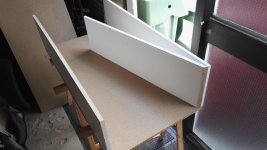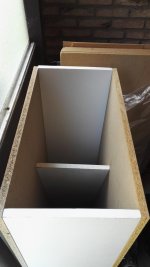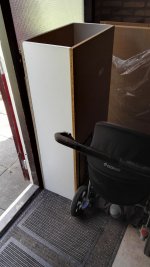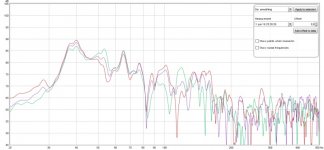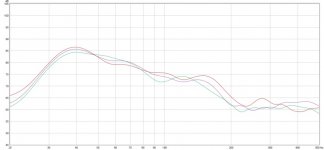I built a single BiB from scrap material. I was restricted to boards I had, so just drew up the largest folded pipehorn I could. Volume is roughly ok for the driver used, a Tangband W69-1042 woofer. This gave ~70Hz tuning frequency and possible in-room response of about 35-40Hz. It's pretty short, so instead of ceiling loading, it's on it's side now with the driver firing into a corner.
I was using two of these woofers in sealed boxes, Q 0.5, which combines well with my room. Bass didn't drop off at all! I really needed the dual sub setup to improve modes etc. I was expecting more trouble with room modes and a noticeably less extended bass (we watch violent movies and listen to large orchestral music, deep extension is very noticeable).
The "little" BiB with one driver sounds MUCH more dynamic and relaxed than two sealed subs with the same driver. Response does go down to about 35 Hz and is remarkably similar when measured at various positions. While I miss some known sound effects down low when I know about them, the overall sound suggests much lower response.
It's really very anonymous, blends to my "satelite" BiBs very well. I thought the tiny drivers were limiting dynamic capabilities, but it turns out it was the subs. The new sub-BiB changes performance dramatically.
I now desperately want to build a pair if 40hz BiBs. I drew up a pair of 12" FAST BiBs, but they were firmly vetoed. My first WAF incident! I'm looking into a pair of 8" FAST BiBs now. It's just an inch smaller here and there, not shorter. I don't really u derstand why she will allow those and not the others, but anyway... Not worth a fight. 🙂
Thanks Scott, GM, and of course Terry. I remember he was friendly and respected back then. Wonderful to see he leaves a lasting legacy.
pictures please.
I built a single BiB from scrap material. I was restricted to boards I had, so just drew up the largest folded pipehorn I could. Volume is roughly ok for the driver used, a Tangband W69-1042 woofer. This gave ~70Hz tuning frequency and possible in-room response of about 35-40Hz. It's pretty short, so instead of ceiling loading, it's on it's side now with the driver firing into a corner.
I was using two of these woofers in sealed boxes, Q 0.5, which combines well with my room. Bass didn't drop off at all! I really needed the dual sub setup to improve modes etc. I was expecting more trouble with room modes and a noticeably less extended bass (we watch violent movies and listen to large orchestral music, deep extension is very noticeable).
The "little" BiB with one driver sounds MUCH more dynamic and relaxed than two sealed subs with the same driver. Response does go down to about 35 Hz and is remarkably similar when measured at various positions. While I miss some known sound effects down low when I know about them, the overall sound suggests much lower response.
It's really very anonymous, blends to my "satelite" BiBs very well. I thought the tiny drivers were limiting dynamic capabilities, but it turns out it was the subs. The new sub-BiB changes performance dramatically.
I now desperately want to build a pair if 40hz BiBs. I drew up a pair of 12" FAST BiBs, but they were firmly vetoed. My first WAF incident! I'm looking into a pair of 8" FAST BiBs now. It's just an inch smaller here and there, not shorter. I don't really u derstand why she will allow those and not the others, but anyway... Not worth a fight. 🙂
Thanks Scott, GM, and of course Terry. I remember he was friendly and respected back then. Wonderful to see he leaves a lasting legacy.
Sorry but if there are no pictures of the deed, it didn't happen 😀
I had particle boards sized 62x125 cm and 30x125cm. I put these together as seen in the pictures. Only the slanted panel needed to be cut. Driver placement is 0.5xL. I placed it on the classic bottom panel (which is on the side in my case, since it's lying on its side). Driver panel is not in the pictures.
The white panels are cheap standard shelving, particleboard laminated with melamine. It actually looks very good. For a next BiB, I am considering using it for the baffle, rear and slanted panel, between some kind of solid wood for the sides.
The white panels are cheap standard shelving, particleboard laminated with melamine. It actually looks very good. For a next BiB, I am considering using it for the baffle, rear and slanted panel, between some kind of solid wood for the sides.
Attachments
Sweeps with REW, no filtering applied. Red line is the hot seat, level is uncalibrated. Unsmoothed and psychoacoustic smoothing. Room gain starts at about 60-70 Hz here. I did DSP with REW and minidsp, now I just run it from the subout of my AVR with Audussey. That handles it well enough.
It's a very reliable yet flexible design algorithm I think, I built two BiB designs and both perform very well.
It's a very reliable yet flexible design algorithm I think, I built two BiB designs and both perform very well.
Attachments
Thanks Scott, GM, and of course Terry.
You're welcome! Gotta love high acoustic efficiency. 😀
GM
I am preparing to build another BiB. One the one end, the 70 Hz BiB impresses far more than expected, on the other it just makes me really curious about what else is down there. 😀
I have at my disposal 4x Tangband W69-1042 and 2x Eminence Kappa 12. Simply putting these drivers into the BiB calculator gives a volume of 205 liters for a single W69-1042 and 436 liters for a single Kappa 12.
I can manage the 205 liters of the tangband, the 436 for the 12" Eminence is a bit overboard. But I know Scott and GM did some undersized BiBs, that there is some margin. I read somewhere in this thread that about 3x Vas is about the lower limit. For the K12, that would be about the lower limit of a successful BiB?
I have at my disposal 4x Tangband W69-1042 and 2x Eminence Kappa 12. Simply putting these drivers into the BiB calculator gives a volume of 205 liters for a single W69-1042 and 436 liters for a single Kappa 12.
I can manage the 205 liters of the tangband, the 436 for the 12" Eminence is a bit overboard. But I know Scott and GM did some undersized BiBs, that there is some margin. I read somewhere in this thread that about 3x Vas is about the lower limit. For the K12, that would be about the lower limit of a successful BiB?
Duh... 3x Vas. But I mean, is that still Is that still OK, or would you give it a bit more yourself?
Dunno; I never 'thought' in these terms when I experimented with pipe horns since I always fine tuned them with some form of vent in lieu of stuffing density since efficiency was always a prime goal.
Bottom line for a TC 'BIB'; less is always less [lower bass output] with decreasing acoustic efficiency [net Vb], though in the case of a 'sub' BIB where tuning is to ~Fs and room/boundary gain will boost the lower end to a greater or lesser extent, it normally doesn't need to be anywhere near full size based on my math that assumes a 2pi space to allow more tuning flexibility with stuffing density.
Just guessing since I've no time/programs loaded to experiment, but my 'knee jerk' SWAG is that calculating it based on a ~1.56x Fs alignment and maybe fine tuned by reducing the terminus with an empirically arrived at constriction [vent, negating the need for much in the way of damping] will suffice; so what net Vb does this yield?
Note that the horn length still ideally needs to be long enough to get close enough to the ceiling same as any BIB, though of course not necessary if floor loaded.
GM
Bottom line for a TC 'BIB'; less is always less [lower bass output] with decreasing acoustic efficiency [net Vb], though in the case of a 'sub' BIB where tuning is to ~Fs and room/boundary gain will boost the lower end to a greater or lesser extent, it normally doesn't need to be anywhere near full size based on my math that assumes a 2pi space to allow more tuning flexibility with stuffing density.
Just guessing since I've no time/programs loaded to experiment, but my 'knee jerk' SWAG is that calculating it based on a ~1.56x Fs alignment and maybe fine tuned by reducing the terminus with an empirically arrived at constriction [vent, negating the need for much in the way of damping] will suffice; so what net Vb does this yield?
Note that the horn length still ideally needs to be long enough to get close enough to the ceiling same as any BIB, though of course not necessary if floor loaded.
GM
OK, thanks GM. If it's that flexible and lenient, I will just have to figure out what's practical in my situation.
I have little facilities for large scale woodworking, so like to use pre-finished boards. I'm looking at ABS-coated particle board now, comes in just the right oak "inspired" finish to match some of our other furniture. Board width is limited to 30, 40 and 60 cm. Due to some interior decorating considerations, I don't want to go over 50cm, so I can only use the 30 and 40 cm boards.
Fairly limited really. Not that easy to get a lot of volume that way. Using interior width of 30 cm and exterior depth of 40 cm, I get a ~2 meter high BiB with 205 liter, perfect for the TB W69-1043. Seems a little limited for the K12, or am I too cautious? I guess I should just build one and try out both drivers. Why not? 😀
Next thing to think about is bracing. I am looking at the bracing of the CSS Trio 12 BiB. Lots of holes, seems a lot of work. I think I'd rather cut out some larger holes, different shapes and more following the panels they are attached to. But tjhere's probably a reason Scott designed in those holes?
I have little facilities for large scale woodworking, so like to use pre-finished boards. I'm looking at ABS-coated particle board now, comes in just the right oak "inspired" finish to match some of our other furniture. Board width is limited to 30, 40 and 60 cm. Due to some interior decorating considerations, I don't want to go over 50cm, so I can only use the 30 and 40 cm boards.
Fairly limited really. Not that easy to get a lot of volume that way. Using interior width of 30 cm and exterior depth of 40 cm, I get a ~2 meter high BiB with 205 liter, perfect for the TB W69-1043. Seems a little limited for the K12, or am I too cautious? I guess I should just build one and try out both drivers. Why not? 😀
Next thing to think about is bracing. I am looking at the bracing of the CSS Trio 12 BiB. Lots of holes, seems a lot of work. I think I'd rather cut out some larger holes, different shapes and more following the panels they are attached to. But tjhere's probably a reason Scott designed in those holes?
An externally hosted image should be here but it was not working when we last tested it.
The LABhorn. An older Tom Danley design, it has unperforated panels for bracing.
I didn't really see pics of recent tapped horn designs by Danley inside, so don't know his current views on bracing.

We know the holey brace thing.

I see this too.
Option one is easiest, obviously. Option two looks like a lot of work, but perhaps it isn't with a hole cutter on a power drill. The last option seems quicker, but maybe it will take me more time to think out the shape of the cut out.
I tend to overthink stuff, slowing my projects down tremendously if I'm not careful. With these standard width and pre-finished boards, I just need to cut them to length, drill and insert dowels and glue them together. I can do that in a day, in my experience. Would be a tremendous shame if I spend weeks or months on the bracing.

Bracing;
I have used hardwood dowels and rails for bracing with good success. Look at my second picture on post 5310 on pg. 531. The only challenge would be to drill angled holes in the rails mounted on the inside panel for the dowels.
I have used hardwood dowels and rails for bracing with good success. Look at my second picture on post 5310 on pg. 531. The only challenge would be to drill angled holes in the rails mounted on the inside panel for the dowels.
OK, thanks GM. I have little facilities for large scale woodworking......
Seems a little limited for the K12, or am I too cautious? I guess I should just build one and try out both drivers. Why not? 😀
Next thing to think about is bracing.
You're welcome! Understood.......... Again, what net Vb does a 1.56x Fs tuning calc? 'Sounds' like a plan if it will fit. Note too that for a bass/'sub', the driver can be 2x further down the pipe.
[A lot of] [different size] holes/[window pane] cutouts in braces are only required when one wants a ~unimpeded air flow and/or make them as light as practical and/or has a use for the scrap. Consequently, a very high aspect ratio cab's bracing doesn't need them along its axial [long] length, only in its cross sectional bracing and why some of us just use dowels and/or rigid scrap strips and/or 1x or 1.5x 2, 3, etc., boards/timber as required to create a 'window pane' or matrix bracing scheme. The main thing is to tie all panels together to keep them from 'breathing' with minimal loss of acoustic efficiency.
GM
Note the bracing of DSL's huge dual high power handling 15" DTS10 TH: http://i264.photobucket.com/albums/ii175/brandonnash/DSCF3496.jpg
Obviously yours will have flimsier panels, but then you won't be using much power to vibrate them, so offsetting solid vertical braces or multiple dowels or similar to mimic them, which can do double duty to mass load/brace the driver like Dave/Scott, et al do, then do some multiple dowels or similar horizontally, tying them to the vertical ones to create 'X' braces is all you need. Gets rid of a lot of scrap too since one can cut up/piece them together as required.
GM
Obviously yours will have flimsier panels, but then you won't be using much power to vibrate them, so offsetting solid vertical braces or multiple dowels or similar to mimic them, which can do double duty to mass load/brace the driver
GM
You're welcome! Understood.......... Again, what net Vb does a 1.56x Fs tuning calc? 'Sounds' like a plan if it will fit. Note too that for a bass/'sub', the driver can be 2x further down the pipe.
What do you mean, 1.56x Fs tuning? Do you mean 1.56x Vas? Or really resonance frequency?
1.56x Vas for the W69 driver gives 38*1.56= 59,28 Liter
1,56x Vas for the Kappa 12 driver gives 112.1*1.56= 174,879 Liter
Note the bracing of DSL's huge dual high power handling 15" DTS10 TH: http://i264.photobucket.com/albums/ii175/brandonnash/DSCF3496.jpg
Aha! I looked at similar shots of the DTS10 TH, but on my smartphone and didn't see there was bracing there at all. Now on a bigger screen, it's very clear. Thanks.
Also thanks to Ed.
Very good visual material, helps a lot.
What do you mean, 1.56x Fs tuning? Or really resonance frequency?
Well, I meant what I posted, but had forgotten how I'd set up the BIB calculation, so was totally wrong for what I wanted to know. 😱
You posted that the TB was big enough, so was only concerned with the woofer, which I assume is a 12A and not the original 12........
Regardless, glad you questioned it; so for a BIB, what net Vb does Vas/1.44 yield?
GM
- Home
- Loudspeakers
- Full Range
- Terry Cain's BIB -why does it work and does anyone have those Fostex Craft Handbooks?
